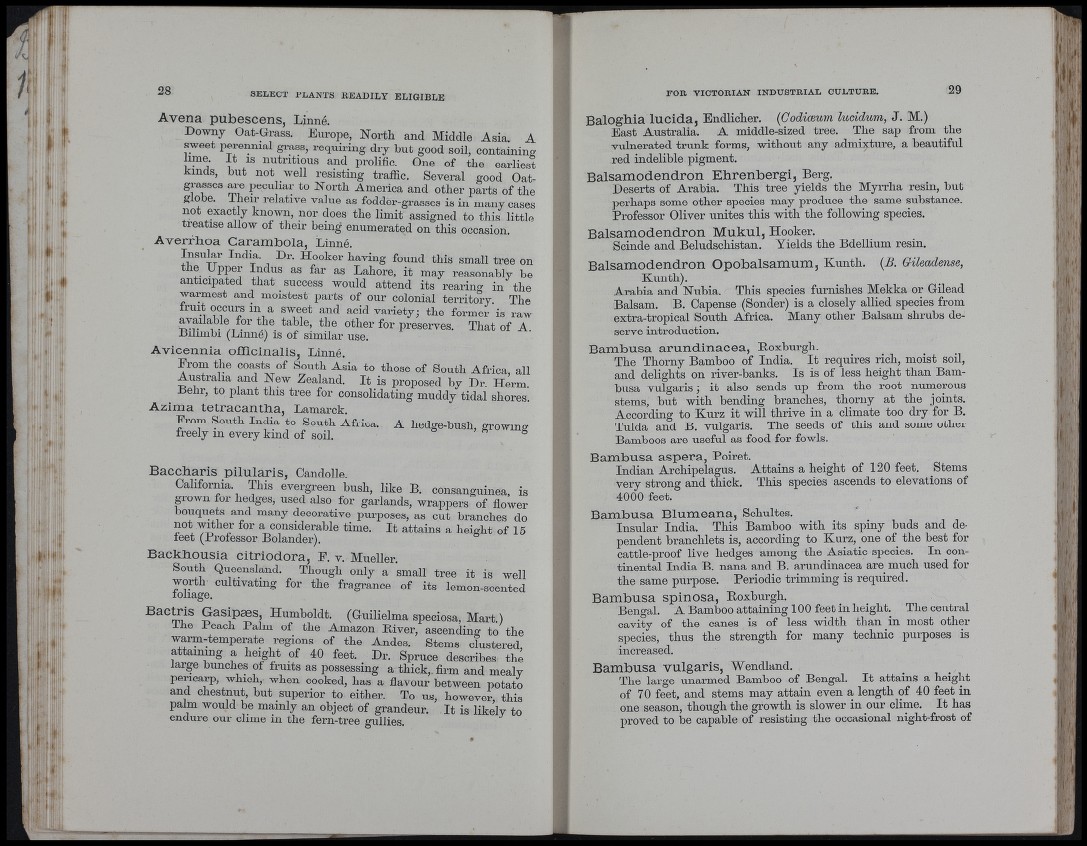
f
/ f i '
Y I Ik
Î
t-i '
f ’ "
I
M ^
Avena pubescens, Linné.
Downj Oat-Grass. Europe, North and Middle Asia. A
sweet perennial grass, requiring dry but good soil, containing
ime. I t is nutritious and prolific. One of the earliest
kinds, but not well resisting traffic. Several good Oat-
grasses are peculiar to North America and other parts of the
globe. Their relative value as fodder-grasses is in many cases
not exactly known, nor does the limit assigned to this little
treatise allow of their being enumerated on this occasion.
Averrhoa Carambola, Linné.
Insular India. Dr. Hooker having found this small tree on
the Upper Indus as far as Lahore, it may reasonably be
anticipated that success would attend its reariim in the
warmest and moistest parts of our colonial territoV The
fruit occum in a sweet and acid variety; the former is raw
available for the table, the other for preserves. That of A.
Eilimbi (Lmne) is of similar use.
Avicennia officinalis, Linné.
From the coasts of South Asia to those of South Africa, all
Australia and New Zealand. I t is proposed by Dr. Herm.
Belir, to plant this tree for consolidating muddy tidal shores.
Azima tetracantha, Lamarck.
From South India to South Africa. A hedge-bnsh, growing
freely in every kind of soil. ^
Baccharis pilularis, Candolle.
California. This evergreen bush, like B. consanguiiiea, is
grown for hedges, used also for garlands, wrappers of fiower
bouquets and many decorative purposes, as cut branches do
not wither for a considerable time. I t attains a height of 15
feet (Professor Bolander).
Backhousia citriodora, E. v. Mueller.
South Queensland. Though only a small tree it is well
worth cultivating for the fragrance of its lemon-scented
loliage.
(Guilielma speciosa, Mart.)
Ih e Peach Palm of the Amazon Biver, ascending to the
warmAemperate regions of the Andes. Stems clustered
attaming a height of 40 feet. Dr. Spruce describes the
large bunches of fruits as possessing a thick, firm and mealy
pericarp, which, when cooked, has a flavour between potato
and chestnut, but superior to either. To us, however, this
palm would be mainly an object of grandeur. I t is likelv to
endure our clime in the fern-tree gullies.
Baloghia lucida, Endlicher. [Codiceum lucidum, J. M.)
East Australia. A middle-sized tree. The sap from the
vulnerated tru n k forms, without any admixture, a beautiful
red indelible pigment.
Balsamodendron Ehrenbergi, Berg.
Deserts of Arabia. This tree yields tlie Myrrha resin, but
perhaps some other species may produce the same substance.
Professor Oliver unites this with the following species.
Balsamodendron Mukul, Hooker.
Scinde and Beludschistan. Yields the Bdellium resin.
Balsamodendron Opobalsamum, Kunth. {B. Gileadense,
Knnth).
Arabia and Nubia. This species furnishes Mekka or Gilead
Balsam. B. Capense (Sonder) is a closely allied species from
extra-tropical South Africa. Many other Balsam shrubs deserve
introduction.
Bambusa arundinacea, Roxburgh.
The Thorny Bamboo of India. I t requires rich, moist soil,
and delights on river-banks. Is is of less height than Bambusa
vulgaris; it also sends up from the root numerous
stems, but with bending branches, thorny at the joints.
According to Kurz it will thrive in a climate too dry for B.
Tnlda and B. vulgaris. The seeds of this and some other
Bamboos are useful as food for fowls.
Bambusa aspera, Poiret.
Indian Archipelagus. Attains a height of 120 feet. Stems
very strong and thick. This species ascends to elevations of
4000 feet.
Bambusa Blumeana, Schultes.
Insular India. This Bamboo with its spiny buds and dependent
branchlets is, according to Kurz, one of the best for
cattle-proof live hedges among the Asiatic species. In continental
India B. nana and B. arundinacea are much used for
the same purpose. Periodic trimming is required.
Bambusa spinosa, Roxburgh.
Bengal. A Bamboo attaining 100 feet in height. The central
cavity of the canes is of less width than in most other
species, thus the strength for many technic purposes is
increased.
Bambusa vulgaris, Wendland.
The large unarmed Bamboo of Bengal. I t attains a height
of 70 feet, and stems may attain even a length of 40 feet in
one season, though the growth is slower in our clime. I t has
proved to be capable of resisting the occasional night-frost of